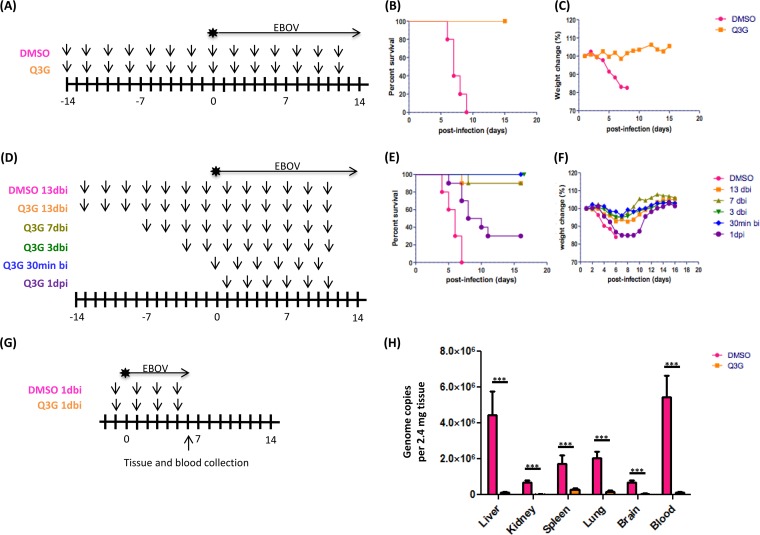FIG 2.
Prophylactic treatment with Q3G promotes survival and inhibits Ebola virus replication. (A) Experimental plan outlining treatment. Six- to eight-week-old female C57BL/6 mice (Charles River) were treated with 50 mg/kg of Q3G (n = 10) or 10% DMSO (n = 10) via intraperitoneal injection. Mice in both groups received a challenge dose of 1,000× LD50 of mouse-adapted Ebola virus (Mayinga isolate) in 200 μl of PBS (pH 7.4) by intraperitoneal injection. (B and C) Survival (B) and changes in weight (C) of Q3G-treated and untreated mice. (D) Experimental plan outlining treatment. Six- to eight-week-old female C57BL/6 mice were treated with 50 mg/kg of Q3G (n = 10) or 10% DMSO (n = 10) via intraperitoneal injection. Mice in both groups received a challenge dose of 1,000× LD50 of mouse-adapted Ebola virus (Mayinga isolate) in 200 μl of PBS (pH 7.4) by intraperitoneal injection. 13dbi, 13 days before infection; 1dpi, 1 day postinfection. (E and F) Survival (E) and changes in weight (F) of Q3G-treated and untreated mice. (G) Experimental plan outlining treatment. Six- to eight-week-old female BALB/c mice were treated with 50 mg/kg of Q3G (n = 10) or 10% DMSO (n = 10) via intraperitoneal injection. Mice in both groups received a challenge dose of 1,000× LD50 of mouse-adapted Ebola virus (Mayinga isolate) in 200 μl of PBS (pH 7.4) by intraperitoneal injection. (H) Virus in the blood, liver, kidney, spleen, lung, and brain was quantified by RT-qPCR amplification of the Ebola virus L gene in Q3G-treated and untreated mice on day 6.

